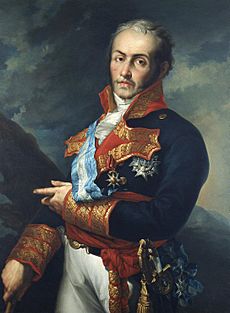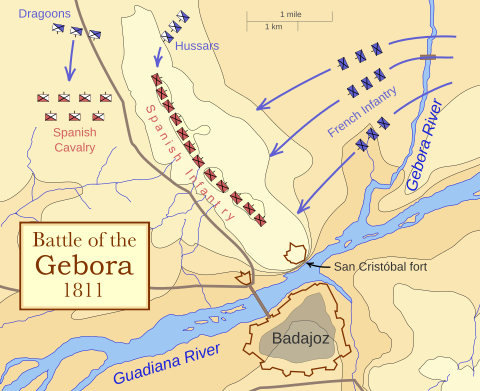Battle of the Gebora facts for kids
Quick facts for kids Battle of the Gebora |
|||||||
|---|---|---|---|---|---|---|---|
| Part of the Peninsular War | |||||||
 View of Badajoz, across the Guadiana river from the foothills of the San Cristóbal heights, by Eugène-Ferdinand Buttura |
|||||||
|
|||||||
| Belligerents | |||||||
| Commanders and leaders | |||||||
|
|||||||
| Strength | |||||||
| 7,000 | 12,000 | ||||||
| Casualties and losses | |||||||
| 400 killed, wounded or captured | 1,000 killed or wounded 4,000 captured |
||||||
The Battle of the Gebora was an important fight during the Peninsular War. This war involved France, Spain, and Portugal. On February 19, 1811, a smaller French army faced a larger Spanish army. The battle happened near Badajoz, Spain.
The French army won a big victory. They almost completely destroyed the Spanish Army of Extremadura. This win helped the French focus on capturing the city of Badajoz.
Contents
Why the Battle Happened
The Peninsular War and Portugal
The Peninsular War was a long conflict in Spain and Portugal. It was part of the bigger Napoleonic Wars across Europe. In 1810, French Marshal André Masséna's army was stuck in Portugal. They were blocked by strong defenses called the Lines of Torres Vedras. These lines protected the Portuguese capital, Lisbon.
The British commander, Viscount Wellington, had forced the French to retreat. Masséna's army then camped near Sobral. They stayed there for a month before moving to a new position.
Napoleon's Orders and Soult's Plan
Napoleon, the French Emperor, wanted Marshal Jean de Dieu Soult to help Masséna. Soult commanded the French Army of the South. Napoleon's orders were based on old information. By then, many Allied troops and forts stood between the French and Lisbon.
So, Soult decided on a different plan. He gathered about 20,000 soldiers. He led them into a Spanish region called Extremadura. His goal was to capture the important Spanish fortress at Badajoz. He hoped this would make the Allies move some of their troops away from Lisbon.
French Advance into Extremadura
Soult split his army into two groups. They marched into Extremadura from different directions. They planned to meet up in Almendralejo. One group, led by General Marie Victor Latour-Maubourg, faced little trouble.
On January 3, 1811, Latour-Maubourg's group met some Spanish and Portuguese cavalry. This cavalry was just covering the retreat of a Spanish infantry division. So, Latour-Maubourg was able to reach Almendralejo easily. He waited there for the second French group.
The second group was led by Soult himself. They were bringing heavy siege equipment. Bad weather and Spanish drivers running away caused problems. The artillery got separated from the soldiers. Also, 5,000 Spanish troops under General Francisco Ballesteros threatened them.
Soult sent General Honoré Gazan's soldiers to deal with Ballesteros. Ballesteros retreated without much fighting. Soult continued to Almendralejo with only his cavalry. This meant he arrived with only a small part of his army and no heavy guns.
Events Before the Battle
The Capture of Olivenza
Because his army was smaller, Soult changed his plans. He couldn't attack a strong fortress like Badajoz without more troops. He sent his light cavalry to take Mérida. He also left some dragoons at Albuera to watch Badajoz. Then, he marched to surround Olivenza.
Wellington had told the Spanish commander, General Pedro Caro de La Romana, to either destroy Olivenza's defenses or make them stronger. La Romana told General Mendizábal to destroy the fort. But Mendizábal ignored this order. Instead, he sent four battalions to make the fort's defenses stronger.
Soult arrived at Olivenza on January 11. The fort was well-defended but not strong enough. The heavy French artillery finally arrived on January 19. By January 22, a weak spot in the fort's walls was opened again. The Spanish soldiers surrendered on January 23. Over 4,000 Spanish troops were captured.
Siege of Badajoz Begins
Soult now had a problem. He had many cavalry soldiers, but only 5,500 infantry. He had to send two battalions to take the prisoners from Olivenza back to Seville. Even though his siege equipment had arrived, General Gazan's soldiers were still missing.
Despite these issues, Soult decided to attack Badajoz. He hoped Wellington would send help to the Spanish fortress. This would reduce the Allied forces facing Masséna in Portugal. On January 26, Soult marched to Badajoz. His cavalry blocked the northern approach. By January 27, the first siege of Badajoz had begun. Gazan's division finally joined Soult's army on February 3. This added 6,000 more soldiers to the French forces.
Mendizábal Takes Command
Meanwhile, Mendizábal had retreated to the Portuguese border. He had sent two battalions to help defend Badajoz. His army was weaker after the loss at Olivenza. He asked La Romana for more soldiers. On January 14, he received 1,800 men from Abrantes.
Also, about 6,000 troops were sent from the Lines of Torres Vedras. They arrived at Elvas ten days later. With Mendizábal's remaining 3,000 men, a Spanish cavalry division, and Portuguese cavalry, the Allies had almost 15,000 soldiers. This army was supposed to be led by La Romana. However, La Romana died suddenly on January 23. Mendizábal then took command of the army.
Mendizábal Ignores Advice
Before he died, La Romana had met with Wellington. They agreed on a plan. The army was supposed to dig trenches on the San Cristóbal heights. The Gebora and Guadiana rivers would protect the front. The fort of San Cristóbal would protect the right side.
Mendizábal knew this plan. But when he arrived on February 5, he ignored it. He put most of his infantry inside Badajoz. He left only a small group of infantry and his cavalry near San Cristóbal. On February 7, Mendizábal launched a strong attack against the French. The Portuguese cavalry made a fake attack on the French left. Then, 5,000 men attacked the French right.
The Spanish soldiers pushed through the French lines. They fought against one of General Jean-Baptiste Girard's brigades. Marshal Mortier had to send more soldiers to help. The Spanish pulled back to Badajoz. They lost 650 men, and the French lost 400.
On February 9, Mendizábal moved most of his men out of Badajoz. He left 7,000 soldiers to defend the city. His field army of 9,000 infantry settled on the San Cristóbal heights. The 3,000 cavalry camped behind them. Again, Mendizábal ignored Wellington's plan. He did not dig trenches on the heights. He also did not send out cavalry to watch for French movements.
Soult mostly ignored the Spanish army for the next few days. He focused on building his siege lines around Badajoz. Heavy rains made the rivers impassable. So, from February 11 to 18, the French could only fire cannons at the Spanish line. This pushed the Spanish further away from Badajoz and its fort.
The Battle of the Gebora
By the afternoon of February 18, the rain stopped. The Gebora River became shallow enough to cross. That evening, Soult sent soldiers under Mortier's command to the north bank. They crossed the Guadiana River on a special bridge.
General Latour-Maubourg's cavalry joined them. The French now had 4,500 infantry, 2,500 cavalry, and 12 cannons. They were ready to attack the Spanish lines at dawn on February 19.
French Surprise Attack
That morning, there was a thick fog. Mendizábal did not know the French were coming. His lookouts, only a mile from his front, were pushed back. Mortier's infantry was crossing the Gebora River. At the same time, French cavalry climbed the heights to the north. They were also unseen. They attacked one of the Spanish regiments by surprise.
Mortier showed great skill in how he used his small force. He sent all his cavalry north to attack the Spanish left side. Three battalions went south, between the San Cristóbal fort and the Spanish right side. His remaining six infantry battalions attacked the Spanish front.
As the fog lifted, the French light cavalry attacked the Spanish left flank. Latour-Maubourg took three cavalry regiments to attack the Spanish and Portuguese cavalry. Even though the Allies had more cavalry, they ignored orders. They immediately ran away towards Elvas and Campo Maior. They escaped safely. Latour-Maubourg ignored them and attacked the Spanish infantry line instead.
Spanish Defeat
The fight on the Spanish right side was not decided right away. The fog had lifted, so the Spanish could see that the French were fewer in number. They formed their lines and seemed ready to fight. But the French cavalry soon appeared. The light cavalry came along the top of the heights. Latour-Maubourg's cavalry advanced from behind.
Mendizábal formed his troops into two large squares. These squares were supported by cannons. At first, they stopped the French cavalry. But they became an easy target for the French infantry and artillery. One Spanish soldier said, "Their artillery played upon it in a most horrible fashion until it became first an oval and then an unformed mass that the cavalry were able to penetrate and take prisoner."
The French cavalry broke through the Spanish squares easily. The battle was basically over. Some Spanish regiments scattered. Many surrendered. Others tried to fight their way to Badajoz or the Portuguese border.
What Happened Next
The Battle of the Gebora was a major loss for the Allies. Wellington had warned the Spanish generals that their army was "the last body of troops which their country possesses." He later wrote that the defeat was "the greatest misfortune."
The Spanish army was almost completely destroyed. About 2,500 infantry escaped into Badajoz. A slightly smaller number made it to Portugal. But about 1,000 Spanish soldiers were killed or wounded. Another 4,000 were captured. Seventeen cannons were lost. The French had only minor losses. Soult first reported 30 killed and 140 wounded. Later, these numbers were updated to about 400 casualties, mostly cavalry.
Soult was now free to continue his attack on Badajoz. The city's defenses were stronger. About 8,000 soldiers from Mendizábal's defeated army had joined the garrison. But Badajoz eventually fell to the French on March 11.
Wellington then sent a large Anglo-Portuguese army to retake the city. This army was led by Sir William Beresford. By April 20, the second siege of Badajoz had begun. The French tried to stop this siege. This led to the bloody Battle of Albuera on May 16. Beresford's Allied army kept up the siege. They barely managed to hold off a smaller French army, again led by Soult.
However, the French Army of Portugal and the Army of the South joined forces. This combined French army had over 60,000 men. On June 20, they forced Wellington to stop the siege. He pulled his 44,000-man army back to Elvas. Badajoz remained in French hands until the next year. The Allies finally retook it after the Battle of Badajoz.
See also
 In Spanish: Batalla de Gévora para niños
In Spanish: Batalla de Gévora para niños
- Badajoz bastioned enclosure





